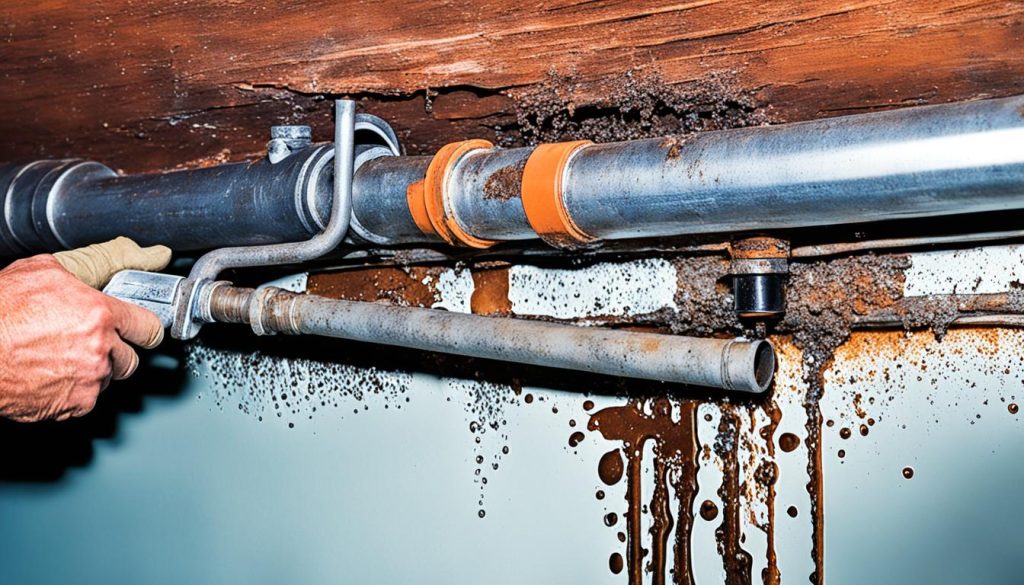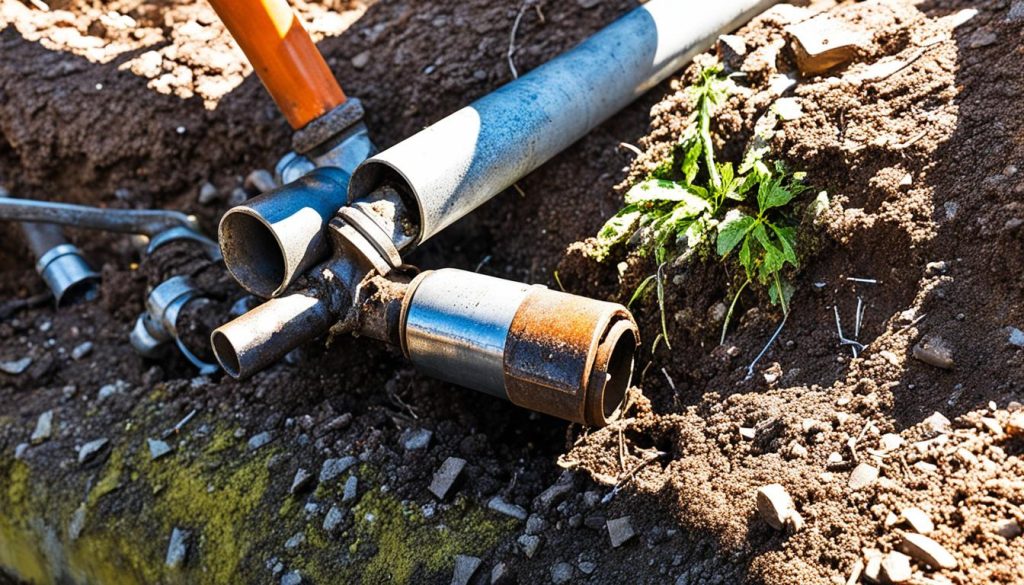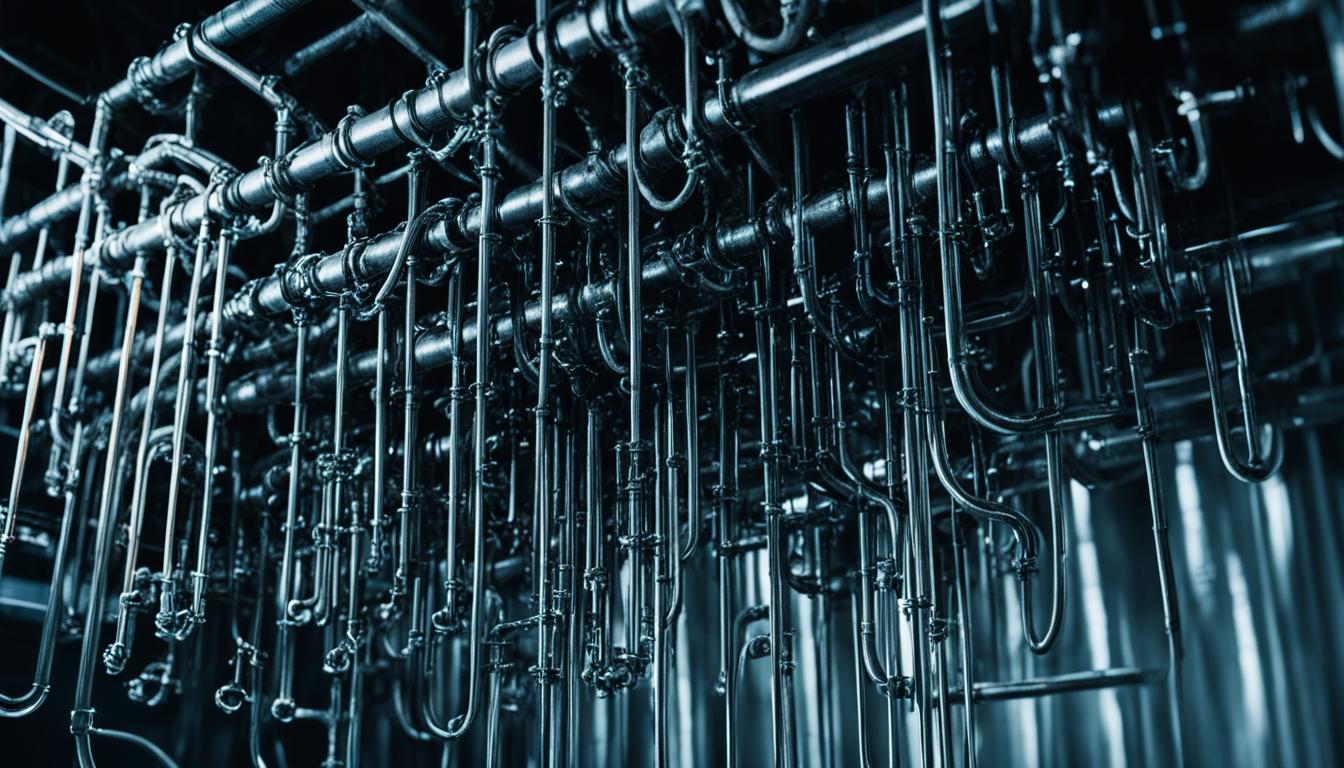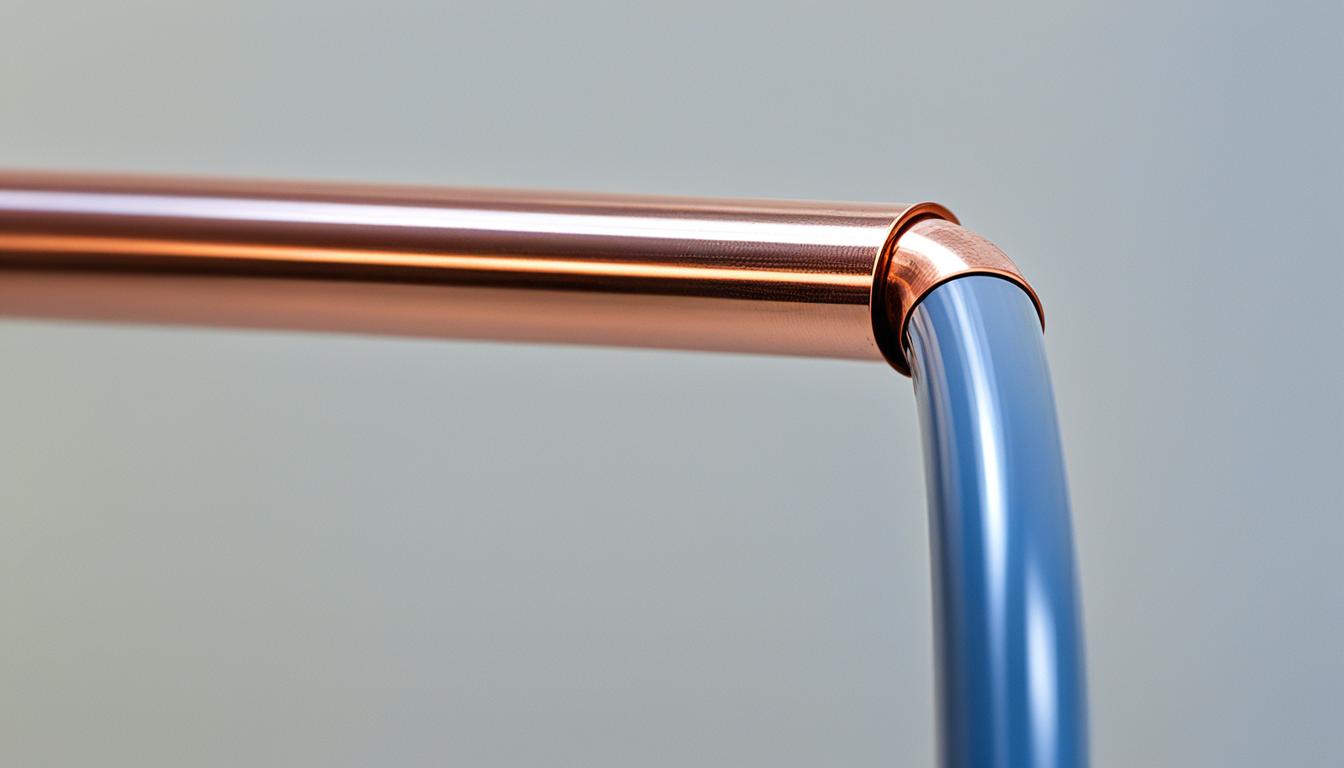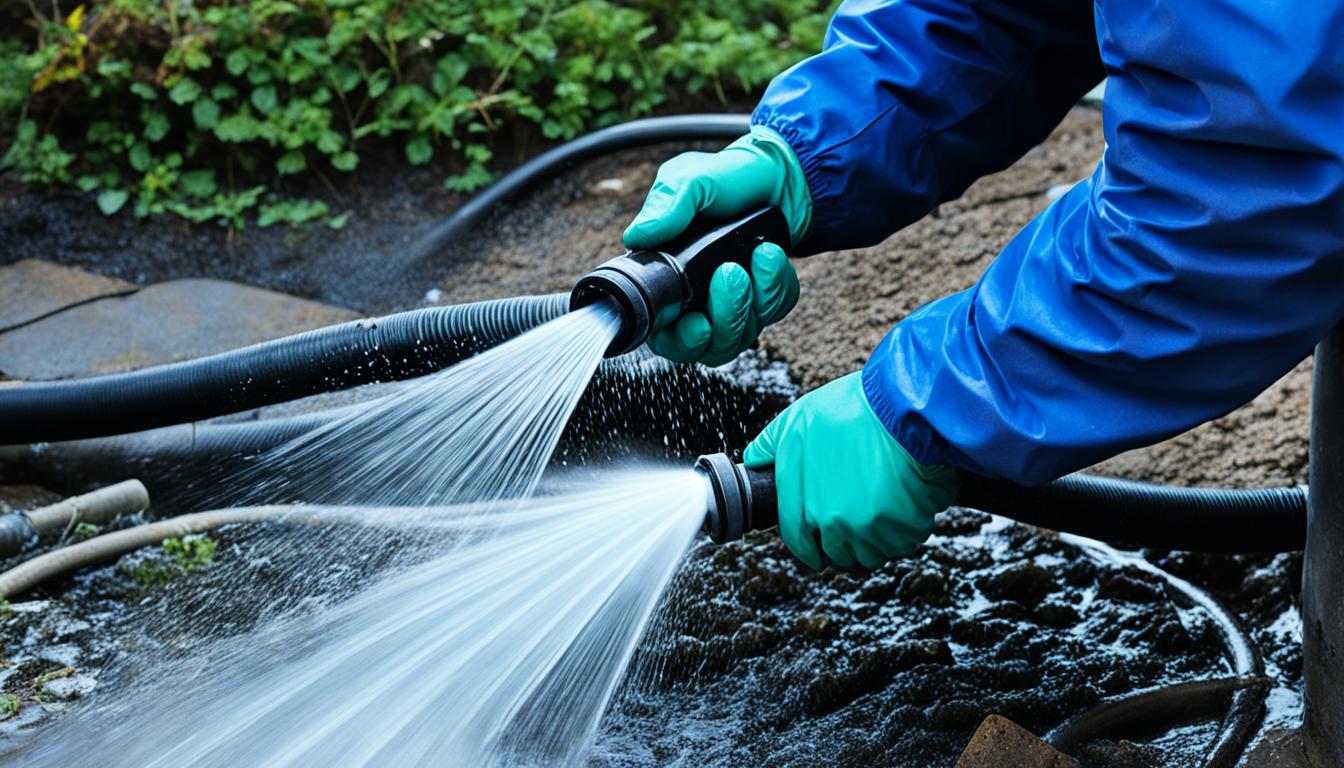Caring for Old House Pipes: Essential Tips
Did you know that many older homes in Canada still have plumbing systems made from clay, cast iron, and galvanized steel? These vintage house pipes, while charming, can be prone to cracking, rusting, and deterioration over time. To keep your old house plumbing in top shape and avoid costly repairs, it’s important to take proper care of these aging pipes.
Key Takeaways:
- Avoid using chemical drain cleaners, as they can corrode non-plastic pipes.
- Regularly check for signs of leakage, such as dripping fixtures and wet cabinets.
- Know the location of shut-off valves and sewer valves for emergencies or repairs.
- Take precautions to protect pipes in cold weather, such as insulation and keeping water running.
- Consider upgrading old pipes when renovating your home.
Understanding Old Home Plumbing Materials
In older homes, plumbing pipes were commonly made of clay, cast iron, or galvanized steel. These materials have their own unique characteristics and challenges.
Clay Pipes
Clay pipes, commonly found in vintage houses, can be prone to cracking and breaking over time. They are susceptible to damage caused by shifting soil or tree root intrusion. Clay pipes require careful maintenance and repair.
Cast Iron Pipes
Cast iron pipes were frequently used in antique house plumbing. Although durable, they can easily rust from the inside out, leading to reduced water flow and eventual pipe failure.
Galvanized Steel Pipes
Galvanized steel pipes were a popular choice for old house piping. Over time, the protective zinc coating wears off, causing the pipes to rust and corrode. This can result in leaks, water discoloration, and reduced water pressure.
Newer homes often utilize PVC and ABS plastic pipes, which offer greater durability and resistance to corrosion. These modern materials are less prone to cracking, rusting, and deterioration compared to their older counterparts.
Comparison of Plumbing Materials
| Plumbing Material | Pros | Cons |
|---|---|---|
| Clay | Fits seamlessly into old plumbing systems | Prone to cracking and breaking |
| Cast Iron | Durable and long-lasting | Easily rusts from the inside out |
| Galvanized Steel | Strong and reliable | Rusts over time as coating wears off |
| PVC and ABS Plastic | Highly durable and resistant to corrosion | May not fit seamlessly into older plumbing systems |
When considering old pipe replacement or upgrading antique house plumbing, it’s important to weigh the pros and cons of various materials and consult with a professional plumber to determine the best course of action.
Maintaining Old Plumbing
When it comes to old house water pipes, regular maintenance is crucial to ensure their longevity and prevent costly repairs. Updating plumbing in old homes may seem daunting, but with proper care, you can keep your aging home plumbing in good condition. Here are some essential tips for maintaining old plumbing:
Avoid Chemical Drain Cleaners
Chemical drain cleaners may seem like a quick fix for clogged pipes, but they can cause further damage, especially to non-plastic pipes. The harsh chemicals in these cleaners can corrode old house water pipes, leading to leaks and potentially costly repairs. Instead, opt for natural drain cleaning methods like baking soda and vinegar or use a drain snake to clear blockages.
Regularly Check for Signs of Leakage
To prevent small leaks from turning into major plumbing issues, it’s important to regularly check for signs of leakage. Keep an eye out for dripping fixtures, wet cabinets, or any unusual moisture around pipes. If you notice any signs of leakage, it’s best to address them promptly to avoid further damage and potential water waste.
Know the Location of Shut-Off Valves
In case of emergencies or plumbing repairs, knowing the location of the main shut-off valve and sewer valve is essential. Familiarize yourself with the valves’ locations, and make sure they are easily accessible. This knowledge can help minimize water damage and facilitate faster repairs when needed.
Protect Pipes in Cold Weather
Cold weather can wreak havoc on old house water pipes, leading to freezing and potential bursts. To protect your plumbing during winter, insulate exposed pipes with pipe insulation sleeves or heat tape. Additionally, keep water running at a slow drip to prevent pipes from freezing. Taking these precautions can save you from the hassle and expense of dealing with frozen or burst pipes.
No matter how old your house’s plumbing is, proper maintenance is key to avoiding major issues and costly repairs. By following these tips for maintaining old plumbing, you can ensure the continued functionality of your aging home plumbing and enjoy peace of mind.
Signs It’s Time to Replace Old Plumbing Pipes
If you own an older home with original plumbing, it’s important to keep an eye out for signs that indicate your pipes may need to be replaced. Ignoring these signs could lead to costly damages and potential health hazards. Here are some key indicators that it’s time for old pipe replacement:
- Rusting Pipes: Over time, metal pipes in older homes can corrode, leading to rust and deterioration. If you notice any signs of rust on your pipes, it’s a clear indication that they need to be replaced.
- Discoloration in Water: If the water coming out of your faucets is discolored, such as a brown or yellow tint, it’s likely that your pipes are deteriorating and leaching contaminants into the water supply. This is a serious issue that requires immediate attention.
- Reduced Water Pressure: Old pipes can develop blockages or become clogged with mineral deposits, resulting in reduced water pressure throughout your home. If you’re experiencing consistently weak water flow, it’s a sign that the pipes need to be replaced.
- Poor Performance of Fixtures and Appliances: If your sinks, toilets, or appliances are not functioning properly, it could be due to old and deteriorating pipes. Clogs, leaks, and other plumbing issues are indicators that it’s time for an upgrade.
When any of these signs are present, it’s crucial to take immediate action and consult with a professional plumber to assess the condition of your plumbing system. They can provide expert advice and recommend the best course of action for renovating old house plumbing and replacing your historic home’s pipes.
Replacing old plumbing pipes is a complex task that requires expertise and professional knowledge. It’s not a DIY project, and attempting it without proper skills can lead to further damage and increased costs. By investing in the replacement of your old pipes, you can ensure the safety, functionality, and longevity of your plumbing system and ultimately protect your historic home for years to come.
Fixing Common Issues with Old Plumbing Pipes
When it comes to old plumbing pipes, it’s common to encounter various issues that require attention. Whether you’re updating plumbing in old homes or renovating an old house plumbing system, addressing these common problems is crucial to ensure proper functionality and avoid potential damage. In this section, I will discuss some of the most common issues with old plumbing pipes and provide practical solutions to fix them.
Corroded Pipes
One of the main issues with old plumbing pipes is corrosion. Over time, pipes made of materials like galvanized steel or copper can corrode, leading to leaks and reduced water quality. To fix corroded pipes, you can start by cleaning them with appropriate solutions that remove rust and other deposits. Once the pipes are clean, consider applying a corrosion-resistant coating to prevent future corrosion.
Leaking Pipes
Leaking pipes are another common problem that needs immediate attention. If you notice water dripping or pooling around your pipes, it’s likely that there is a leak. In such cases, you should replace the damaged section of the pipe by cutting out the affected area and installing new piping materials. PVC or PEX pipes are excellent choices for replacements due to their durability and resistance to corrosion.
Low Water Pressure
Dealing with low water pressure can be frustrating, especially in old homes. If you’re experiencing reduced flow from your faucets and showerheads, there may be blockages or other issues within the plumbing system. Start by checking for any obstructions in the pipes, such as mineral deposits or debris. Clearing these blockages can help improve water pressure. In some cases, installing a booster pump might be necessary to ensure adequate water flow throughout your home.
By addressing these common issues with old plumbing pipes, you can help to improve the overall performance and functionality of your plumbing system. However, it’s essential to remember that certain issues might require professional assistance. Consult with a qualified plumber if you’re unsure about the best course of action or if you need help with more complex plumbing repairs.
- “How to Fix Common Plumbing Problems in Old Houses.” Bob Vila, www.bobvila.com/articles/1832-plumbing-in-an-older-house.
- “Dealing with Common Plumbing Problems.” The Spruce, www.thespruce.com/common-plumbing-problems-1824863.
Best Practices for Maintaining Old Plumbing Pipes
When it comes to old house pipes, proper maintenance is essential to ensure their longevity and avoid costly damage. By following these best practices, you can keep your antique house plumbing in optimal condition.
Firstly, it’s important to avoid using harsh chemicals that can corrode the pipes. Instead, opt for natural alternatives or enzymatic drain cleaners that are safe for old plumbing. Additionally, always be mindful of what goes down the drains. Avoid disposing of grease, coffee grounds, and other substances that can cause clogs and blockages.
Proper usage of garbage disposals is also crucial. Avoid overloading the disposal unit and always run plenty of water while using it. Remember to only flush human waste and toilet paper in toilets to prevent any potential plumbing issues.
Preventing frozen pipes is another key consideration, especially in cold climates. Insulating exposed pipes and letting faucets drip during freezing temperatures can help prevent them from freezing and bursting. Regularly scheduling sewer line maintenance, softening water to reduce mineral buildup, and maintaining correct water pressure are also important measures to preserve the integrity of old plumbing pipes.
Lastly, regular inspections of your old house pipes are vital. Look out for signs of leaks, discoloration in water, or reduced water pressure. If you spot any issues, promptly consult with a professional plumber to determine if pipe replacement is necessary. By taking these proactive steps, you can ensure the continued functionality of your antique house plumbing for years to come.
Source Links
- https://dropconnect.com/maintaining-old-plumbing-pipes/
- https://stmatthewsplumbing.com/4-tips-maintaining-old-plumbing/
- https://simplygreenplumbing.com/11-tips-on-maintaining-your-homes-water-lines/
- Investing Wisely: How Windows & Doors in Boost Property Value and Financial Health - April 24, 2025
- The Financial Impact of Personal Injuries: Why Legal Help Matters for Business Owners - April 16, 2025
- The Hidden Financial Costs of Domestic Assault: What Business Owners Need to Know - April 16, 2025
